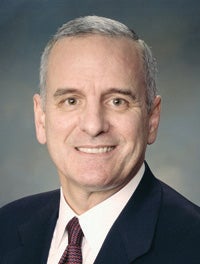Economic forecast eases state budget stress
Published 10:03 am Friday, March 1, 2013
By Albert Lea Tribune and Associated Press
ST. PAUL — Minnesota’s budget pressures eased dramatically on Thursday, but not the political rift over how to shore up the state’s finances.
The Department of Minnesota Management and Budget slashed an earlier deficit projection by more than 40 percent, leaving legislators with a more manageable $627 million shortfall as they set a budget over the next few months. Republicans said the report validated their hold-the-line approach to spending while in power; the Democrats who are now in charge didn’t budge from a stance that higher taxes are still needed to improve the economy for the long haul.
A burst of unanticipated tax collections accounted for most of the improvement, although some is attributable to a smaller than expected increase in school enrollment and reduced health and welfare caseloads.
Legislators have held off plunging too deeply into the budget process until the release of the new economic report.
“Now that we got these numbers, we know where we’re at,” said Sen. Dan Sparks, DFL-Austin. “We continue to see some good signs.”
District 27A Rep. Shannon Savick, DFL-Wells, said though the new budget forecast numbers are an improvement, there is still work to be done.
“We can’t be satisfied with having a smaller deficit,” Savick said. “Now is the time to make wise investments in education, property tax relief and jobs so we don’t have to continually solve for budget deficits moving forward.”
She said the investments will help create a strong middle class through education and creating more living wage jobs.
Democratic Gov. Mark Dayton said he hasn’t decided whether to scale back tax increases he proposed when the projected deficit was pegged at $1.1 billion in December. He said he was leaning toward recommending tax credits for renters and giving businesses a tax break for new equipment purchases. Even with those, he would still have room in the budget to play with.
“I’m open to anything right now,” Dayton said.
But he and Democrats who control the Legislature said the next two-year budget needs to include strategic new spending on education, economic development and other areas in order to position the state for the future.
House Speaker Paul Thissen said Dayton’s proposed tax hike on the top 2 percent of income earners remains likely. Neither Thissen, of Minneapolis, nor Senate Majority Leader Tom Bakk, of Cook, would rule out other new taxes the governor recommended.
“We still have a big chunk we have to deal with just to get back to zero,” Thissen said, adding, “It’s not just about filling a hole.”
House Minority Leader Kurt Daudt, R-Crown, said his party’s refusal to increase state taxes over the prior two years worked and he warned against changing course now.
“The only people who think this wouldn’t be good news are the ones who want to raise taxes,” he said.
State Economist Tom Stinson said Minnesota owes its fiscal progress to a national economy that is gradually healing, strength in the corporate sector, people cashing in on a rising stock market and a housing sector that has genuinely recovered. He said Minnesota is on pace to add 40,000 jobs this year, a figure that will be pinched only slightly if the federal government’s budget impasse results in across-the-board spending cuts.
By year’s end, Minnesota will have gained back all of the jobs it shed during the Great Recession, according to the budget report.
There is some immediate impact from the forecast before a single budget bill moves through the Legislature. A new projection for the budget year that closes in June shows a surplus of $295 million. Almost all of it is required to be used to pay IOUs to Minnesota schools, reducing a backlog in deferred payments to $801 million.
Minnesota has lurched from deficit to deficit for most of the past decade, and lawmakers have resorted to temporary fixes to get by. They have delayed school aid payments, borrowed against a tobacco lawsuit settlement and plugged in one-time federal stimulus dollars for programs that require ongoing spending.
Dayton tried a new tack this year with a proposal to raise billions of dollars in new taxes. But it has stirred fierce opposition from conservatives and business leaders, who say it would make the state less competitive.
David Olson, the president of the Minnesota Chamber of Commerce business lobby, said the report gives lawmakers reason to abandon the idea of raising taxes.
“We’re starting to see the positive impact of previous budget measures that focused on spending restraint vs. large tax increases,” he said.
Dayton’s proposal would impose a new tax rate for couples on taxable income above $250,000, hike taxes on cigarettes and rental cars, charge higher taxes to Minnesota corporations with overseas earnings and demand tax payments from “snowbirds” who spend most of their year living in another state. But the most controversial aspect is his bid to broaden the state sales tax to services such as haircuts and legal bills, and to clothing purchases that exceed $100.
Dayton has also suggested lowering the sales tax rate from 6.875 percent to 5.5 percent, cutting the basic corporate tax rate, freezing business property taxes, cutting unemployment taxes paid by companies and giving all homeowners a $500 property tax rebate.
The net effect would add more than $2 billion in new revenue to the state coffers — half of which would go toward erasing the deficit and the rest toward new spending on education, economic development programs and other priorities.
Groups supportive of Dayton’s budget were just as adamant that he stand firm. Doug Dooher, president of the Education Minnesota teachers union, said spending the governor has suggested for preschool through colleges is vital for the state’s long-term health.
“That means building a strong foundation for young learners through all-day kindergarten, giving kids personal attention in smaller class sizes and, finally, providing affordable post-secondary education,” Dooher said.
Dayton said he would present a revised budget in the second week in March as well as a borrowing plan for publicly financed construction projects. Legislative leaders said they would release the broad parameters of their own budget plans before lawmakers break for the Easter/Passover recess on March 22.








